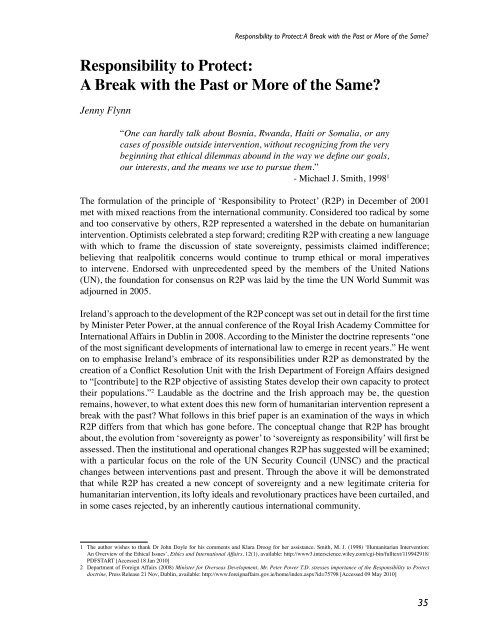Defence Forces Review 2010
Defence Forces Review 2010
Defence Forces Review 2010
You also want an ePaper? Increase the reach of your titles
YUMPU automatically turns print PDFs into web optimized ePapers that Google loves.
Responsibility to Protect: A Break with the Past or More of the Same?Responsibility to Protect:A Break with the Past or More of the Same?Jenny Flynn“One can hardly talk about Bosnia, Rwanda, Haiti or Somalia, or anycases of possible outside intervention, without recognizing from the verybeginning that ethical dilemmas abound in the way we define our goals,our interests, and the means we use to pursue them.”- Michael J. Smith, 1998 1The formulation of the principle of ‘Responsibility to Protect’ (R2P) in December of 2001met with mixed reactions from the international community. Considered too radical by someand too conservative by others, R2P represented a watershed in the debate on humanitarianintervention. Optimists celebrated a step forward; crediting R2P with creating a new languagewith which to frame the discussion of state sovereignty, pessimists claimed indifference;believing that realpolitik concerns would continue to trump ethical or moral imperativesto intervene. Endorsed with unprecedented speed by the members of the United Nations(UN), the foundation for consensus on R2P was laid by the time the UN World Summit wasadjourned in 2005.Ireland’s approach to the development of the R2P concept was set out in detail for the first timeby Minister Peter Power, at the annual conference of the Royal Irish Academy Committee forInternational Affairs in Dublin in 2008. According to the Minister the doctrine represents “oneof the most significant developments of international law to emerge in recent years.” He wenton to emphasise Ireland’s embrace of its responsibilities under R2P as demonstrated by thecreation of a Conflict Resolution Unit with the Irish Department of Foreign Affairs designedto “[contribute] to the R2P objective of assisting States develop their own capacity to protecttheir populations.” 2 Laudable as the doctrine and the Irish approach may be, the questionremains, however, to what extent does this new form of humanitarian intervention represent abreak with the past? What follows in this brief paper is an examination of the ways in whichR2P differs from that which has gone before. The conceptual change that R2P has broughtabout, the evolution from ‘sovereignty as power’ to ‘sovereignty as responsibility’ will first beassessed. Then the institutional and operational changes R2P has suggested will be examined;with a particular focus on the role of the UN Security Council (UNSC) and the practicalchanges between interventions past and present. Through the above it will be demonstratedthat while R2P has created a new concept of sovereignty and a new legitimate criteria forhumanitarian intervention, its lofty ideals and revolutionary practices have been curtailed, andin some cases rejected, by an inherently cautious international community.1 The author wishes to thank Dr John Doyle for his comments and Klara Droog for her assistance. Smith, M. J. (1998) ‘Humanitarian Intervention:An Overview of the Ethical Issues’, Ethics and International Affairs, 12(1), available: http://www3.interscience.wiley.com/cgi-bin/fulltext/119942918/PDFSTART [Accessed 18 Jan <strong>2010</strong>]2 Department of Foreign Affairs (2008) Minister for Overseas Development, Mr. Peter Power T.D. stresses importance of the Responsibility to Protectdoctrine, Press Release 21 Nov, Dublin, available: http://www.foreignaffairs.gov.ie/home/index.aspx?id=75798 [Accessed 09 May <strong>2010</strong>]35
















